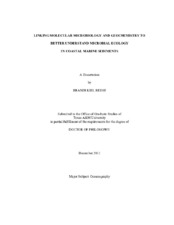| dc.contributor.advisor | Mills, Heath J. | |
| dc.contributor.advisor | Morse, John W. | |
| dc.creator | Reese, Brandi Kiel | |
| dc.date.accessioned | 2012-02-14T22:19:41Z | |
| dc.date.accessioned | 2012-02-16T16:16:34Z | |
| dc.date.available | 2014-01-15T07:05:33Z | |
| dc.date.created | 2011-12 | |
| dc.date.issued | 2012-02-14 | |
| dc.date.submitted | December 2011 | |
| dc.identifier.uri | https://hdl.handle.net/1969.1/ETD-TAMU-2011-12-10365 | |
| dc.description.abstract | The overall objective of the research presented here was to combine multiple geochemical parameters and molecular characterizations to provide a novel view of active microbial community ecology of sediments in a large-river deltaic estuary. In coastal and estuarine environments, a large portion of benthic respiration has been attributed to sulfate reduction and implicated as an important mechanism in hypoxia formation. The use of high-resolution sampling of individual sediment cores and high throughput nucleic acid extraction techniques combined with 454 FLX sequencing provided a robust understanding of the metabolically active benthic microbial community within coastal sediments. This was used to provide further understanding and show the importance of simultaneously analyzing the connectivity of sulfur and iron cycling to the structure and function of the microbial population. Although aqueous sulfide did not accumulate in the sediments of the northern Gulf of Mexico, active sulfate reduction was observed in all locations sampled. Microbial recycling and sequestration as iron sulfides prevented the release of sulfide from the sediment. Prominent differences were observed between the sample locations and with depth into the sediment column. This study emphasized the importance of combining novel molecular techniques with simultaneous traditional geochemical measurements to show the interdependence of microbiology and geochemistry. In addition, this study highlights the need to consider microbial community biogeography along with small-scale variations in geochemistry and biology that impact the overall cycling of redox elements when constructing biogeochemical models in marine sediments. | en |
| dc.format.mimetype | application/pdf | |
| dc.language.iso | en_US | |
| dc.subject | sulfate reduction | en |
| dc.subject | sulfide | en |
| dc.subject | sediment | en |
| dc.subject | biogeochemistry | en |
| dc.subject | Gulf of Mexico | en |
| dc.subject | microbial ecology | en |
| dc.subject | iron reduction | en |
| dc.subject | methylene blue | en |
| dc.title | Linking Molecular Microbiology and Geochemistry to Better Understand Microbial Ecology in Coastal Marine Sediments | en |
| dc.type | Thesis | en |
| thesis.degree.department | Oceanography | en |
| thesis.degree.discipline | Oceanography | en |
| thesis.degree.grantor | Texas A&M University | en |
| thesis.degree.name | Doctor of Philosophy | en |
| thesis.degree.level | Doctoral | en |
| dc.contributor.committeeMember | Bianchi, Tom S. | |
| dc.contributor.committeeMember | Gentry, Terry | |
| dc.contributor.committeeMember | Santschi, Peter | |
| dc.type.genre | thesis | en |
| dc.type.material | text | en |
| local.embargo.terms | 2014-01-15 | |


